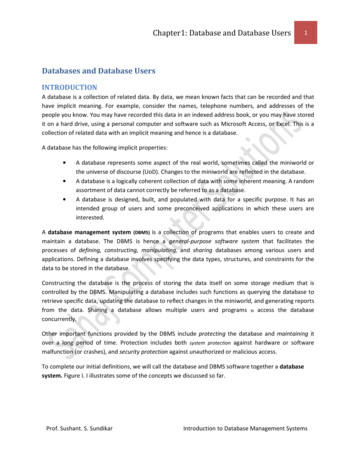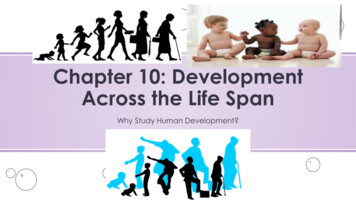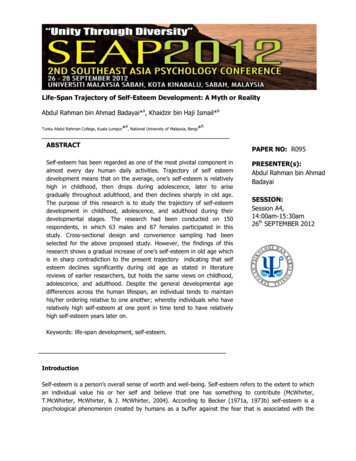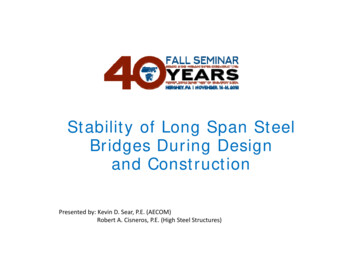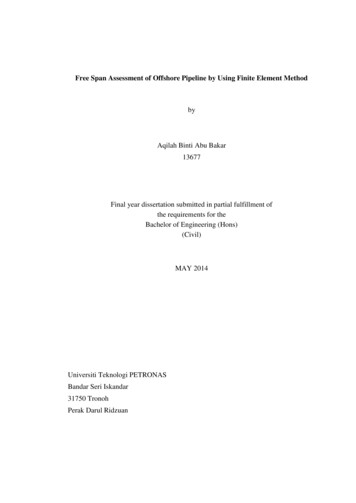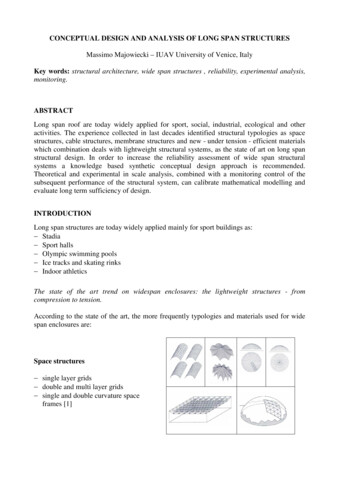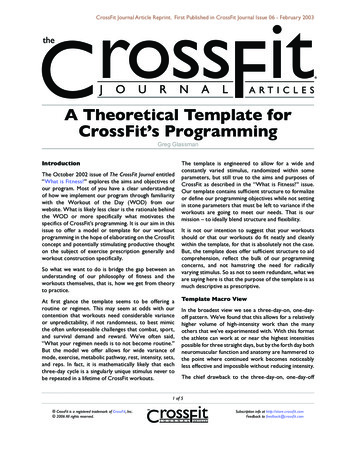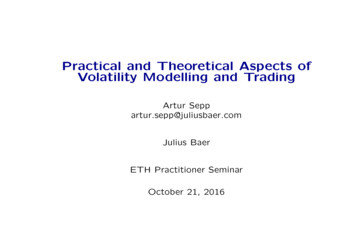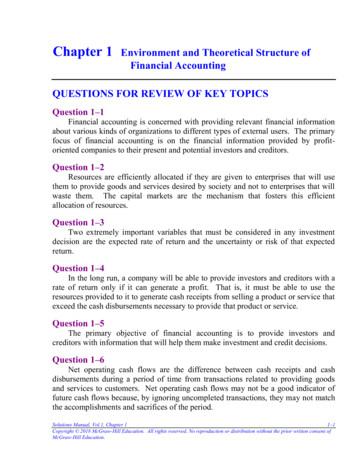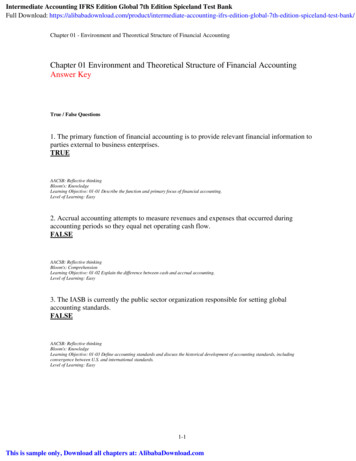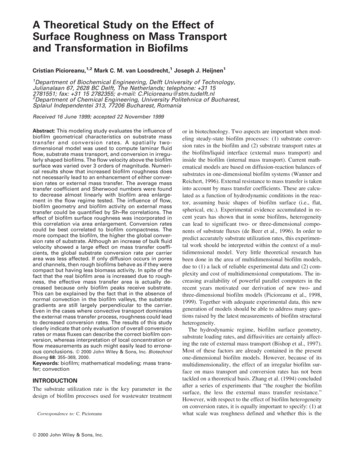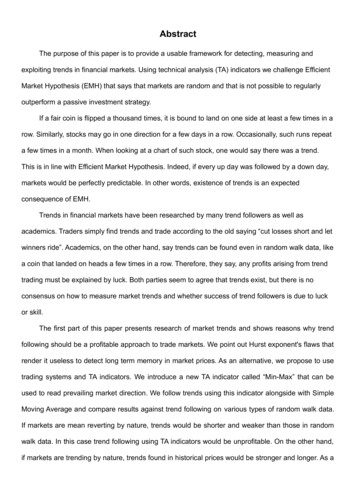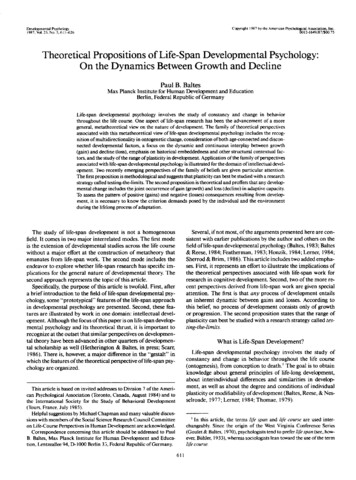
Transcription
Copyright 1987 by the American Psychological Association, Inc.0OI2-l649/87/ 00.75Developmental Psychology1987, Vol. 2.1, No. 5, 611-626Theoretical Propositions of Life-Span Developmental Psychology:On the Dynamics Between Growth and DeclinePaul B. BaltesMax Planck Institute for Human Development and EducationBerlin, Federal Republic of GermanyLife-span developmental psychology involves the study of constancy and change in behaviorthroughout the life course. One aspect of life-span research has been the advancement of a moregeneral, metatheoretical view on the nature of development. The family of theoretical perspectivesassociated with this metatheoretical view of life-span developmental psychology includes the recognition of multidirectionality in ontogenetic change, consideration of both age-connected and disconnected developmental factors, a focus on the dynamic and continuous interplay between growth(gain) and decline (loss), emphasis on historical embeddedness and other structural contextual factors, and the study of the range of plasticity in development. Application of the family of perspectivesassociated with life-span developmental psychology is illustrated for the domain of intellectual development. Two recently emerging perspectives of the family of beliefs are given particular attention.Thefirstproposition is methodological and suggests that plasticity can best be studied with a researchstrategy called testing-the-limits. The second proposition is theoretical and proffers that any developmental change includes the joint occurrence of gain (growth) and loss (decline) in adaptive capacity.To assess the pattern of positive (gains) and negative (losses) consequences resulting from development, it is necessary to know the criterion demands posed by the individual and the environmentduring the lifelong process of adaptation.The study of life-span development is not a homogeneousfield. It comes in two major interrelated modes. The first modeis the extension of developmental studies across the life coursewithout a major effort at the construction of metatheory thatemanates from life-span work. The second mode includes theendeavor to explore whether life-span research has specific implications for the general nature of developmental theory. Thesecond approach represents the topic of this article.Specifically, the purpose of this article is twofold. First, aftera brief introduction to thefieldof life-span developmental psychology, some "prototypical" features of the life-span approachin developmental psychology are presented. Second, these features are illustrated by work in one domain: intellectual development. Although the focus of this paper is on life-span developmental psychology and its theoretical thrust, it is important torecognize at the outset that similar perspectives on developmental theory have been advanced in other quarters of developmental scholarship as well (Hetherington & Baltes, in press; Scan;1986). There is, however, a major difference in the "gestalt" inwhich the features of the theoretical perspective of life-span psychology are organized.This article is based on invited addresses to Division 7 of the American Psychological Association (Toronto, Canada, August 1984) and tothe International Society for the Study of Behavioral Development(Tours, France, July 1985).Helpful suggestions by Michael Chapman and many valuable discussions with members of the Social Science Research Council Committeeon Life-Course Perspectives in Human Development are acknowledged.Correspondence concerning this article should be addressed to PaulB. Baltes, Max Planck Institute for Human Development and Education, Lentzeallee 94, D-1000 Berlin 3 J, Federal Republic of Germany.Several, if not most, of the arguments presented here are consistent with earlier publications by the author and others on thefield of life-span developmental psychology (Baltes, 1983; Baltes& Reese, 1984;Featherman, 1983;Honzik, 1984;Lerner, 1984;Sherrod & Brim, 1986). This article includes two added emphases. First, it represents an effort to illustrate the implications ofthe theoretical perspectives associated with life-span work forresearch in cognitive development. Second, two of the more recent perspectives derived from life-span work are given specialattention. The first is that any process of development entailsan inherent dynamic between gains and losses. According tothis belief, no process of development consists only of growthor progression. The second proposition states that the range ofplasticity can best be studied with a research strategy called testing-the-Umits.What is Life-Span Development?Life-span developmental psychology involves the study ofconstancy and change in behavior throughout the life course(ontogenesis), from conception to death.1 The goal is to obtainknowledge about general principles of life-long development,about interindividual differences and similarities in development, as well as about the degree and conditions of individualplasticity or modifiability of development (Baltes, Reese, & Nesselroade, 1977;Lerner, l984;Thomae, 1979).1In this article, the terms life span and life course are used interchangeably. Since the origin of the West Virginia Conference Series(Goulet & Baltes, 1970), psychologists tend to prefer life span (see, however. Biihler, 1933), whereas sociologists lean toward the use of the termlife course.611
612PAUL B, BALTESIt is usually assumed that child development, rather than lifespan development, was the subject matter of the initial scholarlypursuits into psychological ontogenesis. Several historical reviews suggest that this generalization is inaccurate (Baltes,1983; Groffinann, 1970; Reinert, 1979). The major historicalprecursors of scholarship on the nature of psychological development—byTetensin 1777,Carusin 1808,Quete!etin 1835—were essentially life-span and not child-centered in approach.Despite these early origins of life-span thinking, however, lifespan development has begun to be studied empirically only during the last two decades by researchers following the lead ofearly twentieth century psychologists such as Charlotte Biihler(1933), Erik H. Erikson (1959), G. Stanley Hall (1922), H. L.Hollingworth (1927), and Carl G. Jung (1933).Three events seem particularly relevant to the more recentburgeoning of interest in life-span conceptions; (a) populationdemographic changes toward a higher percentage of elderlymembers; (b) the concurrent emergence of gerontology as a fieldof specialization, with its search for the life-long precursors ofaging (Birren & Schaie, 1985); and (c) the "aging" of the subjects and researchers of the several classical longitudinal studieson child development begun in the 1920s and 1930s (Migdal,Abeles, & Sherrod, 1981; Verdonik & Sherrod, 1984). Theseevents and others have pushed developmental scholarship toward recognizing the entire life span as a scientifically and socially important focus.Added justification for a life-span view of ontogenesis and important scholarly contributions originate in other disciplines aswell. One such impetus for life-span work comes From sociologyand anthropology (Bertaux & Kohli, 1984; Brim & Wheeler,1966; Clausen, 1986;Dannefer, 1984; Elder, 1985;Featherman,1983; Featherman & Lerner, 1985; Kertzer & Keith, 1983;Neugarten & Datan, 1973; Riley, 1985; Riley, Johnson, &Foner, 1972). Especially within sociology, the study of the lifecourse and of the interage and intergenerational fabric of society is enjoying a level of attention comparable with that of thelife-span approach in psychology.Another societal or social raison d'etre for the existence oflife-span interest is the status of the life course in longstandingimages that societies and their members hold about the life span(Philibert, 1968; Sears, 1986). In the humanities, for example,life-span considerations have been shown to be part of everydayviews of the structure and function of the human condition formany centuries. The Jewish Talmud, Greek and Roman philosophy (e.g., the writings of Solon and Cicero), literary works suchas those of Shakespeare, Goethe, or Schopenhauer, all containfairly precise images and beliefs about the nature of life-longchange and its embeddedness in the age-graded structure of thesociety. Particularly vivid examples of such social images of thelife span come from the arts. During the last centuries, manyworks of art were produced, reproduced, and modified in mostEuropean countries, each using stages, steps, or ladders as aframework for depicting the human life course (JoeriBen &Will, 1983; Sears, 1986).These observations on literature, art history, and social images of the life course suggest that thefieldof life-span development is by no means an invention of developmental psychologists. Rather, its recent emergence in psychology reflects the perhaps belated effort on the part of psychologists to attend to anaspect of the human condition that is part and parcel of oureveryday cultural knowledge systems about living organisms.Such social images suggest that the life course is something akinto a natural, social category of knowledge about ontogenesisand the human condition.Is Life-Span Development a Theoryor a Field of Specialization?What about the theoretical spectrum represented by life-spandevelopmental psychology? Is it a single theory, a collection ofsubtheories, or just a theoretical orientation? Initial interest often converges on the immediate search for one overarching andunifying theory such as Erikson's (1959). The current researchscene suggests that in the immediate future life-span developmental psychology will not be identified with a single theory.It is above all a subject matter divided into varying scholarlyspecializations. The most general orientation toward this subject matter is simply to view behavioral development as a lifelong process.Such a lack of theoretical specificity may come as a surpriseand be seen as a sign that the life-span perspective is doomed.In fact, the quest for a single, good theory (and the resultingfrustration when none is offered) is an occasional challenge laidat the doorsteps of life-span scholars (Kaplan, 1983; Scholnick,1985; Sears, 1980). Note, however, that the same lack of theoretical specificity applies to other fields of developmental specialization. Infant development, child development, gerontology,are also not theories in themselves, nor should one expect thatthere would be a single theory in any of these fields. In fact, aslong as scholars look for the theory of life-span developmentthey are likely to be disappointed.A Family of Perspectives Characterizesthe Life-Span ApproachMuch of life-span research proceeds within the theoreticalscenarios of child developmental or aging work. In addition,however, efforts have been made by a feir number of life-spanscholars to examine the question of whether life-span researchsuggests a particular metatheoretical world view (Reese & Overton, 1970) on the nature of development. The theoretical posture proffered by this endeavor is the focus of the remainder ofthis article.For many researchers, the life-span orientation entails severalprototypical beliefs that, in their weighting and coordination,form a family of perspectives that together specify a coherentmetatheoretical view on the nature of development. The significance of these beliefs lies not in the individual items but inthe pattern. Indeed, none of the individual propositions takenseparately is new, which is perhaps one reason why some commentators have argued that life-span work has little new to offer(Kaplan, 1983). Their significance consists instead in the wholecomplex of perspectives considered as a metatheoretical worldview and applied with some degree of radicalism to the studyof development.What is this family of perspectives, which in their coordinated application characterizes the life-span approach? Perhaps no single set of beliefs would qualify in any definite sense.However, the beliefs summarized in Table 1 are likely to beshared by many life-span scholars. They can be identified pri-
LIFE-SPAN DEVELOPMENTAL PSYCHOLOGY613Table 1Summary ofFamily of Theoretical Propositions Characteristic of Life-Span Developmental PsychologyConceptsPropositionsLife-span developmentOntogenetic development is a life-long process. No age period holds supremacy in regulating thenature of development. During development, and at all stages of the life span, both continuous(cumulative) and discontinuous (innovative) processes are at work.MultidirectionalityConsiderable diversity or pluralism is found in the directionality of changes that constituteontogenesis, even within the same domain. The direction of change varies by categories ofbehavior. In addition, during the same developmental periods, some systems of behavior showincreases, whereas others evince decreases in level of functioning.Development as gain/lossThe process of development is not a simple movement toward higher efficacy, such as incrementalgrowth. Rather, throughout life, development always consists of the joint occurrence of gain(growth) and loss (decline).PlasticityMuch intraindividual plasticity (within-person modifiability) is found in psychologicaldevelopment. Depending on the life conditions and experiences by a given individual, his or herdevelopmental course can take many forms. The key developmental agenda is the search for therange of plasticity and its constraints.Historical embeddednessOntogenetic development can also vary substantially in accordance with historical-culturalconditions. How ontogenetic (age-related) development proceeds is markedly influenced by thekind of sociocultural conditions existing in a given historical period, and by how these evolve overtime.Contextualism as paradigmAny particular course of individual development can be understood as the outcome of theinteractions (dialectics) among three systems of developmental influences: age-graded, historygraded, and nonnormative. The operation of these systems can be characterized in terms of themetatheoretical principles associated with contextualism.Field of development as multidisciplinaryPsychological development needs to be seen in the interdisciplinary context provided by otherdisciplines (e.g., anthropology, biology, sociology) concerned with human development. Theopenness of the life-span perspective to interdisciplinary posture implies that a "purist"psychological view offers but a partial representation of behavioral development from conceptionto death.marily from the writings in psychology on this topic (Baltes &Reese, 1984; Baltes, Reese, & Lipsitt, 1980; Lerner, 1984; Sherrod & Brim, 1986), but they are also consistent with sociological work on the life course (Elder, 1985; Featherman, 1983;Riley, 1985).The family of beliefs will be illustrated below, primarily usingthe study of intellectual development as the forum for exposition. Because, historically, the period of adulthood was the primary arena of relevant research, that age period receives mostcoverage. It will also be shown, however, that the metatheoretical posture may shed new light on intellectual development inyounger age groups as well.Empirical Illustration: Research onIntellectual DevelopmentThe area of intellectual functioning is perhaps the best studied domain of life-span developmental psychology. The discussion and elaboration of the empirical and conceptual bases ofthe family of perspectives presented here is selective. The intentis not to be comprehensive but to offer examples of areas ofresearch. (Different researchfindingsand agendas—see, for instance, Keating & MacLean, in press; Perlmutter, in press;Sternberg, in press, for other similar efforts—could have beenused were it not for the particular preferences of the author.)More detailed information on the topic of life-span intelligenceis contained in several recent publications (Baltes, Dittmann-Kohli, & Dixon, 1984; Berg & Sternberg, 1985; Denney, 1984;Dixon & Baltes, 1986; Labouvie-Vief, 1985; Perlmutter, inpress; Rybash, Hoyer, & Roodin, 1986;Salthouse, 1985).Intellectual Development Is a Life-Long ProcessInvolving MultidirectionalityThe first two of the family of perspectives (see Table 1) statethat behavior-change processes falling under the general rubricof development can occur at any point in the life course, fromconception to death. Moreover, such developmental changescan display distinct trajectories as far as their directionality isconcerned.Life-long development- The notion of life-long developmentimplies two aspects. First, there is the general idea that development extends over the entire life span. Second, there is the addedpossibility that life-long development may involve processes ofchange that do not originate at birth but lie in later periods ofthe life span. Considered as a whole, life-long development is asystem of diverse change patterns that differ, for example, interms of timing (onset, duration, termination), direction, andorder.One way to give substance to the notion of life-long development is to think of the kinds of demands and opportunities thatindividuals face as they move through life. Havighurst's (1948/1972; Oerter, 1986) formulation of the concept of developmental tasks is a useful aid for grasping the notion of a life-long
614PAUL B. BALTESsystem of demands and opportunities. Developmental tasks involve a series of problems, challenges, or life-adjustment situations that come from biological development, social expectations, and personal action. These problems "change through lifeand give direction, force, and substance to . . . development."(Havighurst, 1973, p. 11).Thus, the different developmental curves constitutive of lifelong development can be interpreted to reflect different developmental tasks. Some of these developmental tasks—like Havighurst's conception—are strongly correlated with age. However,as will be shown later, such developmental tasks are also constituted from certain historical and nonnormative systems of influence.Multidimensionality and muhidirectionality The termsmultidimensionality and mullidirectionality are among the keyconcepts used by life-span researchers to describe facets of plurality in the course of development and to promote a conceptof development that is not bound by a single criterion of growthin terms of a general increase in size or functional efficacy.Research on psychometric intelligence illustrates the usefulness of multidimensional and multidirectional conceptions ofdevelopment. The psychometric theory offluid-crystallizedintelligence proposed by Cattell (1971) and Horn (1970, 1982)serves as an example (Figure 1). First, according to this theory,intelligence consists of several subcomponents. Fluid and crystallized intelligence are the two most important clusters of abilities in the theory. The postulate of a system of abilities is anexample of multidimensionality. Second, these multiple-abilitycomponents are expected to differ in the direction of their development. Fluid intelligence shows a turning point in adulthood(toward decline), whereas crystallized intelligence exhibits thecontinuation of an incremental function. This is an example ofthe multidirectionality of development.Meanwhile, the Cattell-Horn theoretical approach to lifespan intellectual development has been supplemented withother conceptions, each also suggesting the possibility of multidimensional and multidirectional change. Berg and Stemberg(1985), for example, have examined the implications of Sternberg's triarchic theory of intelligence for the nature of life-longdevelopment. They emphasized that the age trajectories for thethree postulated components of Sternberg's theory of intelligence (componential, contextual, experiential) are likely to varyin directionality.Current work on life-span intelligence (Baltes et al., 1984;Dixon & Baltes, 1986) has also expanded on the Cattell-Hornmodel by linking it to ongoing work in cognitive psychology.Two domains of cognitive functioning are distinguished in a dual-process scheme: the "fluid" mechanics and the "crystallized"pragmatics of intelligence. The mechanics of intelligence refersto the basic architecture of information processing and problem solving. It deals with the basic cognitive operations and cognitive structures associated with such tasks as perceiving relations and classification. The second domain of the dual-process scheme, the pragmatics of intelligence, concerns thecontext- and knowledge-related application of the mechanics ofintelligence. The intent is to subsume under the pragmatics ofintelligence (a) fairly general systems of factual and proceduralknowledge, such as crystallized intelligence; (b) specialized systems of factual and procedural knowledge, such as occupational expertise; and (c) knowledge about factors of perfor-mance, that is, about skills relevant for the activation of intelligence in specific contexts requiring intelligent action. Theexplicit focus on the pragmatics of intelligence demands (likeSternberg's concern with contextual and experiential components) a forceful consideration of the changing structure andfunction of knowledge systems across the life span (see alsoFeatherman, 1983; Keating & MacLean, in press; LabouvieVief, 1985;Rybashetal., 1986).New forms of intelligence in adulthood and old age? Whatabout the question of later-life, "innovative" emergence of newforms of intelligence? It is one thing to argue in principle thatnew developmental acquisitions can emerge at later points inlife with relatively little connection to earlier processes andquite another to demonstrate empirically the existence of suchinnovative, developmentally late phenomena. A classic exampleused by life-span researchers to illustrate the developmentallylate emergence of a cognitive system is the process of reminiscence and life review (Butler, 1963). The process of reviewingand reconstructing one's life has been argued to be primarilya late-life phenomenon. The phenomenon of autobiographicalmemory is another example (Strube, 1985).For the sample case of intelligence, it is an open questionwhether adulthood and old age bring with them new forms ofdirectionality and intellectual functioning, or whether continuation and quantitative (but not qualitative) variation of pastfunctioning is the gist of the process. On the one hand, thereare Flavell's (1970) and Piaget's (1972) cognitive-structuralistaccounts, which favor an interpretation of horizontal decalagerather than one of further structural evolution or transformation. These authors regard the basic cognitive operations asfixed by early adulthood. What changes afterwards is the content domains to which cognitive structures are applied.On the other hand, there are very active research programsengaged in the search for qualitatively or structurally new formsof adult intelligence (Commons, Richards, & Armon, 1984).The work on dialectical and postformal operations by Basseches(1984), Labouvie-Vief(1982, 1985), Kramer (1983), PascualLeone (1983), and other related writings (e.g., Keating &MacLean, in press) are notable examples of this effort. This lineof scholarship has been much stimulated (or even launched) byRiegel's work on dialectical psychology and his outline of a possiblefifthstage of cognitive development (Riegel, 1973, 1976).Other work on adult intellectual development proceeds froma neofunctionalist perspective (Beilin, 1983; Dixon & Baltes,1986) and is informed by work in cognitive psychology. Modelsof expertise (Glaser, 1984) and knowledge systems (Brown,1982) guide this approach in which the question of structuralstages is of lesser significance. Aside from an interest in theaging of the "content-free" mechanics of intelligence (Kliegl &Baltes, in press), the dominant focus is on changes in systemsof factual and procedural knowledge associated with the "crystallized" pragmatics of intelligence. The crystallized form ofintelligence was highlighted already as an ability cluster exhibiting stability or even positive changes into late adulthood. Theconcept of crystallized intelligence, however, needs further expansion to cover additional domains of knowledge and to permit consideration of forms of knowledge more typical of thesecond half of life.Expertise, a concept currently in vogue in cognitive and developmental psychology (Ericsson, 1985; Glaser, 1984; Hoyer,
615LIFE-SPAN DEVELOPMENTAL PSYCHOLOGYDifferent Forms of Crystallized (Pragmatics)Examples:LanguageSocialIntelligence /oSIntelligence asCulturalKnowledgeExamples:MemoryProblem Solving(Symbols, figures)PL,Intelligenceas BasicInformationProcessingca. 25ca. 70AgeFigure 1. One of the best known psychometric structural theories of intelligence is that of Raymond B.Cattell and John L. Horn, (The two main clusters of that theory, fluid and crystallized intelligence, arepostulated to display different life-span developmental trajectories.)1985; Weinert, Schneider, & Knopf, in press), can be used toillustrate this avenue of research. This concept denotes skillsand knowledge that are highly developed and practiced. Thesciences, chess, or job-related activities (e.g., typing) are oftenused as substantive domains in which performance in relationto the acquisition and maintenance of expertise is studied. Thelife course of many individuals most likely offers opportunityfor the practice of such forms of expertise. Therefore, onewould expect that further growth of intellectual functioningmay occur in those domains in which individuals continue topractice and evolve their procedural and factual knowledge(Denney, 1984; Dixon & Baltes, 1986; Hoyer, I9S5; Rybashetal., 1986). In other words, expertise in select facets of the pragmatics of intelligence can be maintained, transformed, or evennewly acquired in the second half of life if the conditions aresuch that selective optimization in the associated knowledgesystem can occur.Two areas of knowledge have been identified as key candidates for domains in which the pragmatics of intelligence mayexhibit positive changes during the second half of life: practicalintelligence (Sternberg & Wagner, 1986) and knowledge aboutthe pragmatics of life, such as is evident in research on socialintelligence and wisdom (Clayton & Birren, 1980; DittmannRohli & Baltes, in press; Holliday & Chandler, 1986; Meacham,1982). Wisdom, in particular, has been identified as a prototypical or exemplar task of the pragmatics of intelligence that mayexhibit further advances in adulthood or whose origins may lieprimarily in adulthood.In one approach (Dittmann-Kohli & Baltes, in press; Dixon& Baltes, 1986; Smith, Dixon, & Baltes, in press), wisdom isdefined as an "expertise in the fundamental pragmatics of life."In order to capture wisdom, subjects of different age groups areasked, for example, to elaborate on everyday problems of lifeplanning and life review. The knowledge system displayed inprotocols of life planning and life review is scored against a setof criteria derived from the theory of wisdom. First evidence(Smith et al., in press) suggests, as expected by the theory, thatsome older adults indeed seem to have available a well-developed system of knowledge about situations involving questionsof life planning. For example, when older adults are asked toexplore a relatively rare or odd life-planning situation involvingother older persons, they demonstrate a knowledge system thatis more elaborated than that of younger adults.The study of wisdom is just beginning. Thus, it is still an openquestion whether the concept of wisdom can be translated intoempirical steps resulting in a well-articulated psychological theory of wisdom. We are somewhat optimistic, inasmuch as cognitive psychologists are increasingly studying tasks and reasoning problems that, like the problems to which wisdom is applied, have a high degree of real-life complexity, and whoseproblem definition and solution involve uncertainty and relativism in judgment (Dorner, in press; Neisser, 1982). In the present context, the important point is that research on wisdom isan illustration of the type of knowledge systems that developmental, cognitive researchers are beginning to study as their attention is focused on later periods of life.
616PAUL B. BALTESLife-span Development:Gain/Loss Ratios in Adaptive CapacityIntellectual Development as a Dynamic Between Growth(Gain) and Decline (Loss)The next belief (see Table 1) associated with life-span work isthe notion that any process of development entails aspects ofgrowth (gain) and decline (loss). This belief is a fairly recentone and its theoretical foundation is not yet fully explored andtested.The gain/loss argument. The gain/loss view of developmentemerged primarily for two reasons. The first relates to the taskof defining the process of aging in a framework of development.The second reason deals with the fact of multidirectionality described earlier and the ensuing implication of simultaneous,multidirectional change for the characterization of development.Concerning the issue of the definition of aging versus development: Traditionally in gerontology, there has been a strongpush—especially by biologists (Kirkwood, 1985)—to define theessence of aging as decline (i.e., as a unidirectional process ofloss in adaptive capacity). Behavioral scientists, because of theirfindings and expectations of some gains in old age, have had atendency to reject this unidirectional, decline view of aging.Thus, they wanted to explore whether aging could be consideredas part of a framework of development.How could this integration of aging into the framework ofdevelopment be achieved in light of the fact that the traditionaldefinition of development was closely linked to growth, whereasthat of aging was linked predominantly to decline? The suggesti
Theoretical Propositions of Life-Span Developmental Psychology: On the Dynamics Between Growth and Decline Paul B. Baltes Max Planck Institute for Human Development and Education Berlin, Federal Republic of Germany Life-span developmental psychology involves the study of constancy and change
